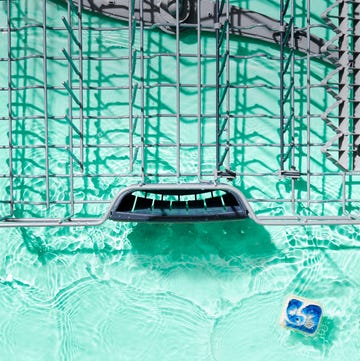15 Things You Should Repair Instead of Replace
Fixing things saves money and helps the planet. It's easy!

As seen on ABC News Now! Fixing things saves money and helps the planet. It's easy!Also see 17 things you can rent, rather than buy.
A Little Love for Old Friends?

Although some people seem to have an uncanny ability to fix things just by touching them (or even just by looking at them), most of us aren't so lucky. Still, there are many benefits to fixing things rather than tossing them out and buying new replacements, from money savings to our own pride and knowledge, not to mention the environment.
It shouldn't surprise you that fixing things rather than buying new can save you a lot of money. In many cases simply sewing on a missing button, touching up a nicked paint job or gluing on a broken corner can get your possessions back up to snuff with only minimal effort and very low expenditure. The trouble is, these days many of us fail to go beyond the easiest small repairs, instead opting to buy new at the smallest sign of trouble.
As E Magazine asked a few years ago, "Whatever Became of Fixing Things?" Travel to the developing world, and you'll see many examples of patched-up products providing long service, from makeshift plumbing to reworked clothing. Our grandparents and great-grandparents were probably quite adept at fixing things up, since stores and funds were often limited. But in America today an abundance of cheap manufactured goods, a consumer culture and relatively high labor costs have conspired to turn us into a bunch of wasters.
Not only are we filling up landfills with stuff that could readily be reused, it takes a great deal of natural resources to make new stuff, in terms of water, minerals, metals, timber, petroleum products and more. Buying new means more transportation and storage costs, and mountains of packaging -- important because experts estimate that 44% of U.S. global warming emissions are due to products and packaging.
The Benefits of Repair

There are other benefits to fixing things, including learning more about how things work, gaining a sense of accomplishment, spending bonding time with children and family members, and preserving heirloom and unique items. You can also buy better quality things, since you'll have more confidence to know that you can repair them and get more value from them.
As much as we have forgotten how to fix things, there is also a resurgence bubbling of those who are strengthening their DIY muscles. Freecycling is a growing marketplace for exchanging used items, some of which need repairs. There's a new green thrifty movement afoot, and even a humor site for wacky repairs.
When do you repair? Some people like the rule of thumb that says you should definitely fix something if the repair costs are less than 50% of the original purchase price. Even if the costs are a bit more there may be something to reducing waste and keeping with what you've already got.
Here are some things that aren't too difficult to fix. And tell us what you've fixed in the comments!
Shoes

Not long ago a trip to the local cobbler was a routine errand. Although it may seem anachronistic, there are actually quite a few shoe repair shops still in business. A friend of mine recently took his beloved sneakers to one in New York City. For $10 he walked out with brand new soles and refurnished inners, so his kicks seem practically new! Sure beats dropping $100+ for comparable replacements.
Favorite hiking, cowboy or snow boots are prime suspects for resoling. And ladies' heels often get broken, while the rest of the shoe remains undamaged. Sometimes sandals just need a bit of sewing or gluing, and many pairs of shoes can be refreshed with new laces or a bit of polish.
Clothes

One entrepreneurial woman in Pennsylvania is happy to take in your worn dress and "recycle it" into something fresh and stylish. Nicole Kulp's Recycle My Dress is a fun concept, and it inspires us to look back through our own wardrobes. It's not too difficult to sew on a missing button, iron on a patch, change a hemline or repair a ripped seam. Friends and family may be able to help you, if you offer to give them a hand in return at, say, cleaning their garage, raking their leaves or whatever else you can barter.
It's also inexpensive to commission repairs at your local tailor or dry cleaner. In New York City it costs around $1.50 to get a button fixed. Replacing a zipper costs around $10, more if the shop provides the zipper. Such minor fees are certainly better than picking out all new duds, perhaps even by thrift store standards.
Luggage

Luggage sure takes a beating, what with busy airport handlers, clanking conveyor belts and jostling in public transportation or loading in and out of cars. But luggage is also expensive, and minor damage can be repaired.
You can patch over rips in luggage, even with heavy tape if you are in a pinch. Replace broken straps or handles with new ones (you can often buy generic ones cheaply at discount stores, or take them off free promotional bags). Glue or tape worn corners. You might even be able to swap out broken wheels. If not call your manufacturer and ask if they have a refurbishment plan. Many designer luggage makers have good programs.
Cars

It may sound obvious that cars need maintenance and repair from time to time, but sometimes we forget this in the hustle and bustle of our busy lives. As with our bodies, good preventative maintenance can go a long ways to staving off pricey problems. Instead of buying a new car every few years, which can really drain your bank accounts, consider keeping cars longer.
If you're handy you may be able to change batteries, oil, fan belts, spark plugs and more by yourself, saving a bundle. If someone in the family is good with cars offer to barter something you're good at in exchange for help. It's also a good idea to find a mechanic you can trust, and who doesn't over charge.
Accessories

Remember that it isn't just apparel that can be repaired. Accessories are ripe for refurbishment. Got a belt that doesn't fit you quite right anymore? Borrow an awl or industrial hole punch and make a quick adjustment. Buckle broken or worn out? Get a replacement from a thrift store and swap it out. Similarly, you can buy a new watch band for just a few dollars, extending the life of your timepiece.
Other jewelry can be repaired with new chains or clasps, or take your items to a jeweler for refitting and new settings. Hats, gloves and scarves can be easy to mend with a bit of darning. Even umbrellas, which frequently break due to their moving parts, can sometimes be fixed with a bit of string.
Home Goods

For some reason laundry baskets seem to break too easily. Yes the plastic bins are inexpensive, but they are also easy to fix. Instead of rushing out to buy a new one every few months, shore up your old one with some tape and a bent coat hanger.
The same goes for picture frames, dishes, knick knacks, clocks, organizers and soft goods. Things around the house get broken from time to time, but a little glue or tape can go a long way.
Electronics and Appliances

Oftentimes there is a simple fix even to complicated things. Maybe you just need a new remote or power cord. Maybe you need to take apart the computer mouse and clean it out, then (hopefully) put it back together.
Back in the days when VCRs cost $700, there was a healthy business of repair shops. These days the economics often don't make sense, and we're essentially exporting our electronics labor overseas when we constantly buy new. We should try to give more thought to repair: there may be instances in which minor repairs may not be too expensive (again, bartering can be a great way to get the job done). Call your manufacturer or try looking up "electronics repair" in the yellow pages.
Keeping appliances in good clean working order will help avoid problems. Many times all that's needed to return to proper functioning is replacing a filter or removing clogs. I've fixed a stalled vacuum cleaner by slipping a belt back on the drive. Sometimes you can replace a broken door latch or do some resealing.
Similarly, sometimes a fresh paint job is all that's needed to transform a worn workhorse into a shiny new appliance. Even if your appliance needs major work, it is often cheaper to call in a service technician for a repair than to buy new (call your manufacturer or look up "appliance repair" in the yellow pages). Do note that older refrigerators, washers and other major appliances may be ripe for replacement, however, if they are very inefficient. You may save more money in the long term by upgrading to energy-efficient models for major use items.
Plants and Trees

Living things can be "fixed" too. Got a houseplant that's not doing well? Don't just throw it out immediately! You might be able to save it by moving it to a sunnier spot, giving it some fertilizer or moving it outdoors in nice weather.
If your trees are ailing, you may need to prune away dead branches and bolster with fertilizer. You may need to prop up the trunk and tie on supports. If you have pest problems look for organic treatments or mineral oils, which can boost the plant's defenses.
If you need help or have any questions, schedule a consultation with a local arborist or landscape designer.
Building Materials

Over time concrete can crack. If you notice the problem before it gets too bad you can often seal over the breaks with a bit of fresh cement. Damaged or rotting wood can be replaced piece by piece, and worn surfaces can be sanded, stained and painted.
If you get a broken window you replace the pane, right? You don't through out the whole frame. Why not extend this practical thinking to other areas of your house, as well as your life?
Furniture

Upholstery shops are still around, and offer you the chance to refurbish a family heirloom or simply a garage sale find precisely to your taste. You pick out the fabric and amount of cushioning, redoing a piece that is unlikely to be found in any other home. Many people enjoy reupholstering as a hobby, and for some basic chairs and other items the task can be a straightforward DIY project.
Similarly, broken furniture can often be fixed up with some nails, glue and patience. If your table is rickety, you may be able to get by with a small board under one leg. Need a temporary table? Place a bit of plywood between two saw horses or stacks of bricks and cover with a pretty cloth. Furniture can be expensive, is often made of virgin wood and takes a lot of storage space if you're not using it all the time.
Leaky Faucets/Toilets

Over time fixtures can start to leak a little bit. It's expensive to call in a plumber, and certainly expensive to put in all new equipment. But small leaks can often be fixed by tightening joints with a pipe wrench or redoing a seal or caulking.
If your toilet is continuously running, you may just need to adjust the chain in the tank (oftentimes the chain simply slips off the handle). You can get a new chain and flapper from a hardware store for a few dollars and swap it out. Also check to make sure your float ball isn't hitting anything, and that it isn't leaking. That's another easy replacement.
David Caruso's Career

The TV bad boy has been blasted by critics and lampooned on South Park for his career decisions. If you think Caruso doesn't get "enuff respect," watch CSI: Miami and help him out.
Your Relationship with Your Parents

Remember that it's not just physical goods that can use repairing! Since you're now in the fix-it spirit, why not give some thought to the important relationships in your life? In fact, you can work on fixing things together with your loved ones, and do both at the same time.
The Planet

The Earth, our only home, has been assaulted by industrial toxins, vehicle emissions, litter, deforestation, overfishing, poaching and many other threats. Our ice caps are melting, our air quality is compromised and species are dying.
Yet it isn't too late to reverse much of the damage! The Earth is also very resilient, and natural systems do have systems in place to repair much of what's been lost. But we need to act now and act decisively. We need lots of small acts, with everyone doing their part, as well as larger policy decisions. We can start by fixing more things and consuming less, but we also need to fix government, the economy and other institutions at the same time.
Sound like a lot of work? It is, but it can also be rewarding, and we're all in this together.


The Right Way to Declutter a Closet

22 Dreamy She Shed Design Ideas

What Is Pattern Drenching?

33 Poisonous Plants You May Have at Home







